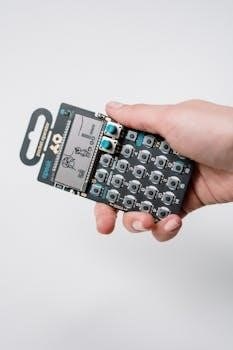Weighmax Scale User Manual⁚ A Comprehensive Guide
Welcome to your comprehensive guide for Weighmax scales! This manual provides essential information for operating and maintaining your scale effectively; Learn about features, calibration, troubleshooting, and care for optimal performance.
Weighmax scales are designed for precision and durability, serving various needs from postal services to personal use. These scales often come pre-calibrated, ensuring accuracy right out of the box. Understanding the features and functions of your Weighmax scale is crucial for optimal performance. Many models offer options for switching between units like pounds/ounces and kilograms/grams, catering to diverse user preferences.
This manual will guide you through the basics, including powering the scale on and off, using the tare function, and understanding error messages. Proper maintenance and care are essential to prolong the life of your Weighmax scale. This includes keeping the scale clean, storing it in a safe place, and avoiding overloading it. This guide is designed to help you use your Weighmax scale effectively and accurately.

Understanding Key Features and Functions
Explore the essential features of your Weighmax scale. Learn about power functions, unit switching (LB/oz & kg/g), and the tare feature for efficient and accurate weighing processes.
Powering On/Off and Auto Power Off
To power on your Weighmax scale, simply press the ON/TARE button. This button serves a dual purpose, both activating the scale and zeroing the display for accurate measurements. To turn the scale off, locate the OFF button and press it. Some models feature an auto power-off function to conserve battery life.
If your scale is powered by a DC 5V adapter, the auto power-off feature may be disabled. In this case, you must manually turn off the scale using the ON/OFF button after each use. This ensures that the scale is completely powered down and prevents unnecessary battery drain.
Understanding these power functions is crucial for efficient and prolonged use of your Weighmax scale. Remember to always turn off the scale when not in use to maximize battery life and ensure accurate readings in the future.
Switching Between Units (LB/oz and kg/g)
Weighmax scales offer the flexibility to measure in different units, typically pounds/ounces (LB/oz) and kilograms/grams (kg/g). Switching between these units is usually straightforward. Locate the MODE button on your scale. This button is specifically designed to cycle through the available measurement units.
Each press of the MODE button will change the displayed unit. Continue pressing the button until your desired unit (LB/oz or kg/g) is shown on the display screen. Once the desired unit is displayed, the scale will use that unit for all subsequent measurements until you change it again.
Remember that the scale may not save your preferred unit setting when powered off. Therefore, you may need to re-select your desired unit each time you turn on the scale. Familiarize yourself with the MODE button location and function for quick and easy unit switching.
Tare Functionality
The tare function is a valuable feature on Weighmax scales, allowing you to weigh items in containers accurately. This function subtracts the weight of the container from the total weight, giving you the net weight of the contents.
To use the tare function, first, place the empty container on the scale platform. Allow the scale to stabilize and display the container’s weight. Next, press the TARE button. The display should now read “0.0” or a similar indication of zero weight. This indicates that the scale has tared the container’s weight.
Now, add the items you want to weigh into the container. The scale will display only the weight of the items, excluding the container’s weight. This is the net weight. When you remove the container, the scale will display a negative weight, representing the tared weight of the container. Press the TARE button again to return the scale to its normal weighing mode.

Calibration Guide
This section provides a guide to calibrating your Weighmax scale for accurate measurements. Proper calibration ensures your scale delivers reliable results. Follow the instructions carefully for best performance.
When to Calibrate Your Weighmax Scale
Knowing when to calibrate your Weighmax scale is crucial for maintaining accuracy. Calibration is recommended when you first receive your scale to ensure it aligns with factory settings. If you notice inconsistent readings, recalibration is necessary.
Temperature changes and humidity fluctuations can affect the scale’s accuracy, indicating a need for calibration. Moving the scale to a new location may also disrupt its precision.
If the scale experiences a significant impact or is dropped, recalibration is essential to restore accuracy. Regular calibration, even without noticeable issues, is a good practice.
For frequent use, calibrate every few months; infrequent use requires less frequent calibration. When the scale displays unusual readings or error messages, consult your user manual for calibration steps.
Step-by-Step Calibration Instructions
To calibrate your Weighmax scale, begin by placing it on a flat, stable surface, ensuring it’s free from vibrations. Turn on the scale and allow it to warm up for at least 30 seconds to ensure the internal components stabilize.
Locate the “CAL” button, often found on the side or underneath the scale. Press and hold this button until the display shows “CAL,” indicating calibration mode. The screen will then prompt you for a specific weight value.
Place the accurately measured calibration weight (refer to your manual for the correct weight) in the center of the platform. The scale will automatically detect the weight and complete the calibration process.
Once finished, the display will show “PASS” or a similar confirmation message. Remove the calibration weight and turn the scale off and then on again to verify the calibration. If readings are still inaccurate, repeat the process.

Troubleshooting
Experiencing issues with your Weighmax scale? This section provides solutions for common problems, including inaccurate readings and overload errors. Follow these troubleshooting steps to resolve any issues and ensure accurate measurements.
Addressing Inaccurate Readings
If your Weighmax scale is displaying inaccurate readings, several factors could be the cause. First, ensure the scale is placed on a flat, stable surface, as uneven surfaces can significantly affect accuracy. Allow the scale to acclimate to room temperature, ideally for at least one hour, before use, as temperature changes can influence readings.
Verify that the scale is properly calibrated. Refer to the calibration guide in this manual for detailed instructions. External interference from other electronic devices can also cause inaccurate readings, so keep the scale away from such devices during operation.
Check the battery level, as a low battery can lead to inconsistent performance. If using an AC adapter, ensure it is securely connected. Finally, make sure the weighing platform is clean and free of any debris that could interfere with accurate measurements. If problems persist, recalibration is often necessary.
Fixing Overload Errors (0 L.D. Display)
Encountering a “0 L.D.” display on your Weighmax scale indicates an overload error, meaning the weight on the scale exceeds its maximum capacity. Immediately remove the excess weight to prevent damage to the scale’s internal sensors. Continued overloading can permanently affect the scale’s accuracy.
After removing the weight, the scale should return to normal operation. If the “0 L.D.” message persists, turn the scale off and then back on to reset it. Ensure you are using the scale within its specified weight limits, typically indicated in the product specifications.
If you consistently encounter this error with weights below the maximum capacity, the scale may require calibration or professional servicing. Avoid placing excessive force or dropping heavy items onto the weighing platform, as this can damage the load cell and cause permanent overload errors.

Maintenance and Care
Proper maintenance ensures longevity and accuracy. Clean gently with a soft, damp cloth. Avoid harsh chemicals. Store in a dry place. Handle with care to prevent damage. Replace batteries as needed.
Proper Handling and Storage
To ensure the longevity and accuracy of your Weighmax scale, proper handling and storage are crucial. Always handle the scale with care, avoiding any sudden impacts or drops, as these can damage the internal components and affect its calibration. When not in use, store the scale in a clean, dry environment, away from extreme temperatures and humidity.
Avoid placing heavy objects on the scale during storage, as this can also lead to inaccurate readings over time. If the scale is equipped with a removable weighing platform, consider storing it separately to prevent scratches or damage. Before storing the scale for an extended period, remove the batteries to prevent corrosion and potential damage to the electronic components.
Regularly inspect the scale for any signs of wear and tear, such as loose parts or damaged sensors. By following these simple guidelines, you can ensure that your Weighmax scale remains in optimal condition for accurate and reliable measurements for years to come.